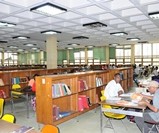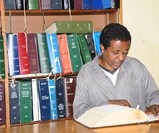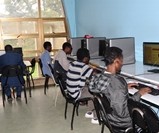More On Libraries Overview
| Subsequently, Pankhurst assumed her responsibility in the University Library with a budget of Birr 70,000 and collection of library materials estimated to be about 35,000 volumes of books and some 220 journals accessible to the faculty, students and researchers.
Being the first university librarian, Pankhurst recognized the university library under a central administration; she played a key role in the development and expansion of the university library. Under her leadership, Ethiopians were sent abroad to study library science. In addition, reclassification and cataloguing project were undertaken with generous from Ford Foundation and US Government. The structure of the central Library System was put in place. The John F. Kennedy Memorial Library Located at Sidist Kilo campus and which serves as the main library was built when Pankhurst was the university Librarian. This magnificent building was financed by USAID grants to the Ethiopian Government. The John F. Kennedy Memorial Library opened in 1970. Presently, along with its branch libraries, the main John F. Kennedy Memorial Library is the hub of the University’s teaching, learning and research activities. The University having recognized this has clearly indicated this fact un its previous and present senate Legislation. Article 140 of the AAU’s Senate Legislation of June 2007, in its general provision on the University Library system affirms that “The University consist of a central Library and such senate constitute Libraries” (2007:240) Over the years, the University Libraries strived to meet the needs of the University’s academic community in their search for information that would enhance teaching and research. This was also reiterate by Taye (1998), “…the Addis Ababa University Library attempted to: (1) fulfil the objectives of the university in teaching and research, (2) develop a pattern of organizational structure which links the library to the university, (3) establish financial control and departmental functions in an attempt at providing efficient services to faculty and students, (4) achieve a degree of integration between the main University Library and its branches, (5) build library resources on Ethiopia which continues to be useful for teaching and research, within the theoretical and alien nature of the curriculum initiated at Addis Ababa University during its formative years.”(1988, iv) The organization structure of the university Library System came into being with the creation of the university itself in 1961. The main tasks of the centeral authority were to coordinate by unifying the previously scattered libraries. These different libraries came under the main University Library; the nucleolus was the University College Library of Addis Ababa. Such undertaking was authorized by the faculty council in 1965; the statue of the University Library was approved in the same year. The present organizational structure came into existence with the spirit and understanding of such background. The overall University Library System constitutes the core activities such as to facilitate the teaching, learning and research process and overall academic activities of the University. Library values Addis Ababa University Libraries’ mission and vision stand on the pillars of the following values: Service: The Libraries offer an environment that supports creativity, flexibility, and collaboration. By understanding that each user requires comfortable, welcoming and secure place for study, research, work, reflection and interaction, we, at the Libraries, commit ourselves to excellence. Knowledge: Addis Ababa University Libraries are committed to: Encouraging the process of learning and the life of the mind; Celebrating truth seeking through discourse and investigation; Anticipating and contributing to scholarly inquiry; Promoting the Library both as a real and virtual extended classroom; Embracing our role as collectors and custodians of the intellectual record. Integrity: The Libraries: Relate to each other with honesty and candor; Adhere to the principles of fairness, justice and equality in their work; Promote the highest standards of profession, including open and equitable access to information; Demonstrate a strong work ethic, taking responsibility for their actions, keeping their word, and following through on their commitments. Respect: The Libraries: Treat everyone with equal consideration and courtesy; Encourage differences in perspective, opinions and ideas; Consider the needs of others; Provide an environment that is inclusive and diverse. Communication: The Libraries:
Collaboration: The Libraries establish partnerships within and outside the University to achieve mutually beneficial goals. Continuous improvement: They maintain a culture of ongoing assessment to improve their collections and services, and to identify, create and implement new services of value. Discovery: The Libraries design an environment that nurtures scholarly exploration for the advancement of education, research, professional development, and intellectual curiosity. Diversity: They respect the beliefs and opinions of those they serve and employ, and offer information resources and programs that reflect the diversity of their institution and community. Learning: They support all learners of all kinds and collaboratively integrate the libraries wherever learning takes place. Moto A center of quality information resources and quality services for excellence! Partnerships The AAU libraries have partnerships with INASP, Eifle, UNISA, US Information Center, ECA Library, and TACC. Awards or Achievements: The Libraries have been awarded different appreciation certificates. Special feature The John F. Kennedy Memorial Library, which was inaugurated on September 12, 1969, has been serving all citizens in the country who need its services as a center of information resources in addition to its main function of serving the University community. |


















